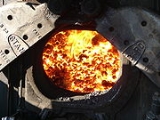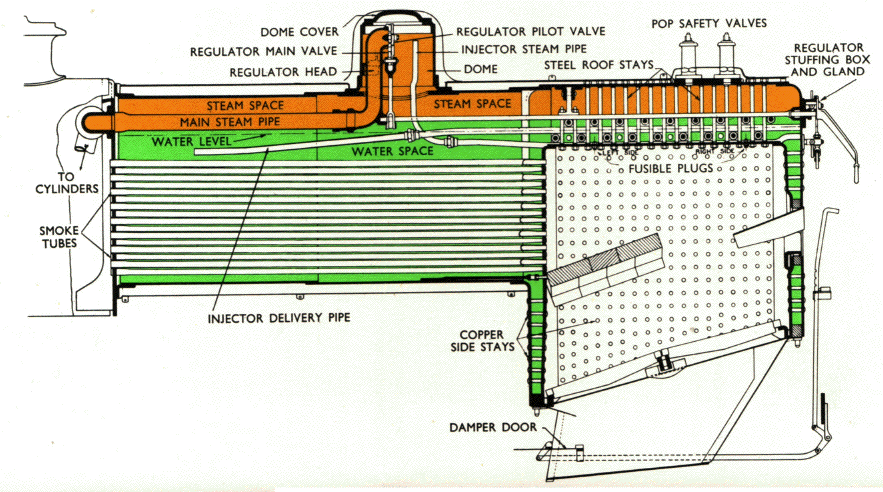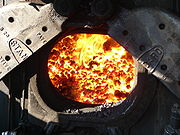
Firebox
Encyclopedia


Steam engine
A steam engine is a heat engine that performs mechanical work using steam as its working fluid.Steam engines are external combustion engines, where the working fluid is separate from the combustion products. Non-combustion heat sources such as solar power, nuclear power or geothermal energy may be...
, the firebox is the area where the fuel
Fuel
Fuel is any material that stores energy that can later be extracted to perform mechanical work in a controlled manner. Most fuels used by humans undergo combustion, a redox reaction in which a combustible substance releases energy after it ignites and reacts with the oxygen in the air...
is burned, producing heat to boil the water in the boiler
Boiler
A boiler is a closed vessel in which water or other fluid is heated. The heated or vaporized fluid exits the boiler for use in various processes or heating applications.-Materials:...
. Most are somewhat box-shaped, hence the name.
Railway locomotive firebox

Steam locomotive
A steam locomotive is a railway locomotive that produces its power through a steam engine. These locomotives are fueled by burning some combustible material, usually coal, wood or oil, to produce steam in a boiler, which drives the steam engine...
firetube type boiler, the firebox is surrounded by water space on five sides. The underside is not so surrounded. If the engine burns solid fuel, there is a grate
Grate
*A grate is a frame of iron bars to hold fuel for a fire.*It may also refer to a covering of a drain, also called a grating.*The act of using a grater, a kitchen utensil.- People :*Don Grate US sportsman....
covering most of the bottom of the firebox to hold the fuel. An ashpan collects the solid combustion waste below. Combustion air generally enters at the base, and the airflow is usually controlled by damper doors.
Brick arch
There is a large brick arch (made from fire brickFire brick
A fire brick, firebrick, or refractory brick is a block of refractory ceramic material used in lining furnaces, kilns, fireboxes, and fireplaces. A refractory brick is built primarily to withstand high temperature, but will also usually have a low thermal conductivity for greater energy efficiency...
) at the front of the box which directs heat and flames back towards the firedoor at the rear. Without the arch, flames would be sucked straight into the firetubes, and only the front of the box would receive heat. The brick arch and the bars of the grate require periodic replacement due to the extreme heat they endure.
Firetubes
Firetubes are attached to one wall of the firebox (the front wall for a longitudinal boiler, the top for a vertical boiler) and carry the hot gaseous products of combustion through the boiler water, heating it, before they escape to the atmosphere.Sheets and stays

Belpaire firebox
Normally the top of the firebox is semicircular to match the contour of the boiler, however the Belpaire fireboxBelpaire firebox
The Belpaire firebox is a type of firebox used on steam locomotives. It was invented by Alfred Belpaire of Belgium. It has a greater surface area at the top of the firebox, improving heat transfer and steam production...
has more of a square shape and is usually made as large as possible within the loading gauge
Loading gauge
A loading gauge defines the maximum height and width for railway vehicles and their loads to ensure safe passage through bridges, tunnels and other structures...
, to offer the greatest heating surface where the fire is hottest.
Wootten firebox
The Wootten fireboxWootten firebox
The Wootten firebox is a type of firebox used on steam locomotives. The firebox was very wide to allow combustion of anthracite coal waste, known as Culm. Its size necessitated unusual placement of the crew, examples being camelback locomotives...
was very tall and wide to allow combustion of anthracite coal
Anthracite coal
Anthracite is a hard, compact variety of mineral coal that has a high luster...
waste. Its size necessitated unusual placement of the crew, examples being camelback locomotive
Camelback locomotive
A camelback locomotive is a type of steam locomotive with the driving cab placed in the middle, astride the boiler...
s.
Combustion chamber
Some fireboxes were equipped with a so-called combustion chamberCombustion chamber
A combustion chamber is the part of an engine in which fuel is burned.-Internal combustion engine:The hot gases produced by the combustion occupy a far greater volume than the original fuel, thus creating an increase in pressure within the limited volume of the chamber...
which placed additional space between the fire and the boiler. This allowed more complete combustion and thus greater heat.
Fireman's duties
The fireman's role on a steam locomotive is to ensure the driverRailroad engineer
A railroad engineer, locomotive engineer, train operator, train driver or engine driver is a person who drives a train on a railroad...
(engineer) has an adequate supply of steam at his disposal at all times. This is achieved by maintaining a supply of fuel to the fire, and by maintaining the boiler water level so that it covers the firebox crown sheet at all times – otherwise, the latter will overheat and weaken, and a boiler explosion
Boiler explosion
A boiler explosion is a catastrophic failure of a boiler. As seen today, boiler explosions are of two kinds. One kind is over-pressure in the pressure parts of the steam and water sides. The second kind is explosion in the furnace. Boiler explosions of pressure parts are particularly associated...
may result. In addition, the fireman also serves as a backup for the driver, keeping a lookout ahead.
Road locomotive firebox
Road locomotives, such as traction engineTraction engine
A traction engine is a self-propelled steam engine used to move heavy loads on roads, plough ground or to provide power at a chosen location. The name derives from the Latin tractus, meaning 'drawn', since the prime function of any traction engine is to draw a load behind it...
s, usually had fireboxes similar to those on railway locomotives but there were exceptions, e.g. the Sentinel steam waggon
Sentinel Waggon Works
Sentinel Waggon Works Ltd was a British company based in Shrewsbury, Shropshire that made steam-powered lorries, railway locomotives, and later, diesel engined lorries and locomotives.-Alley & MacLellan, Sentinel Works, Jessie Street Glasgow:...
which had a vertical water tube boiler.
Stationary boiler firebox
There were, and are, many different designs of firebox for stationary boilers. In flue-type boilers (e.g. the Lancashire boiler) the flues themselves form the firebox. In water-tube boilerWater-tube boiler
A water tube boiler is a type of boiler in which water circulates in tubes heated externally by the fire. Fuel is burned inside the furnace, creating hot gas which heats water in the steam-generating tubes...
s, the firebox is usually a firebrick-lined compartment below the water tubes.
Marine boiler firebox
In marine boilers there are also various types of firebox. The main distinction is, again, between fire-tube types (e.g. the Scotch boiler, with internal firebox) and water-tube types (e.g. the Yarrow boilerYarrow boiler
Yarrow boilers are an important class of high-pressure water-tube boilers. They were developed byYarrows and were widely used on ships, particularly warships....
, with external firebox).

